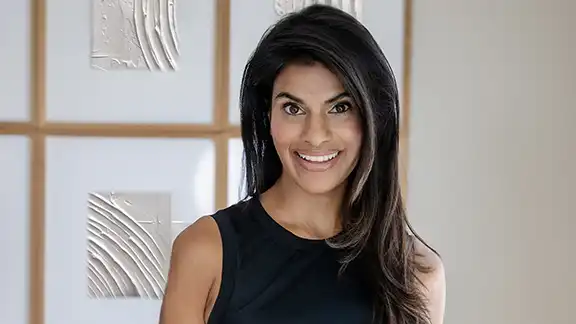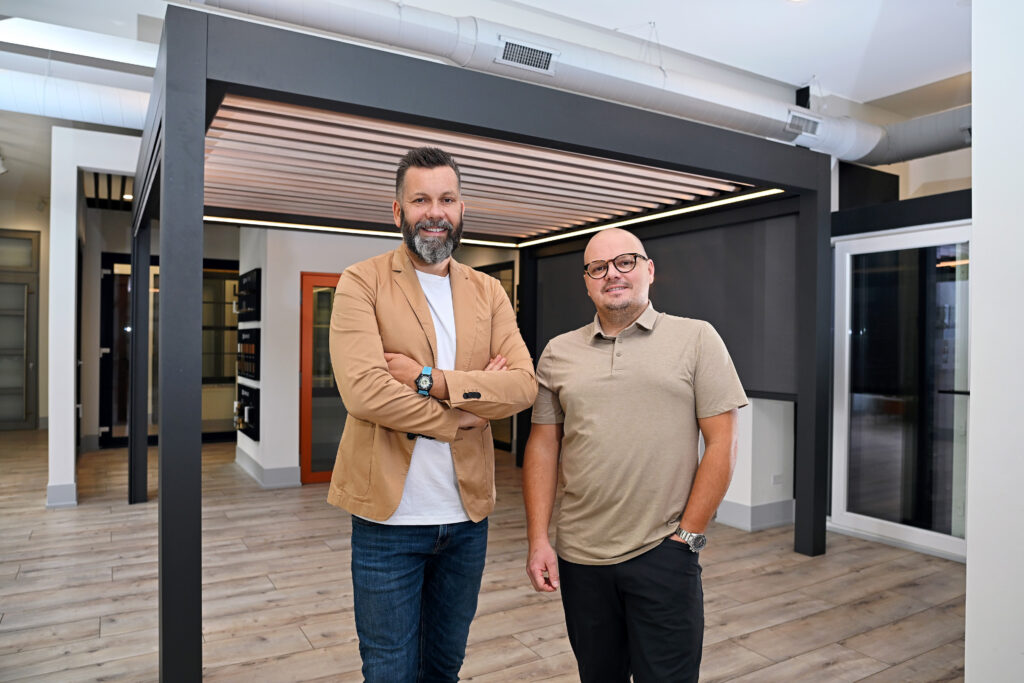
– Tribute to Moms –
By Mike Ellis
the spring of 2020, millions of faces across the nation were riveted to television screens following the progress of the Coronavirus pandemic. From school closures and event cancellations, to daily tallies and hospitalization reports, Americans earnestly sought for whatever information they could glean regarding the global contagion that paralyzed society. But what has it been like actually treating the Coronavirus in the emergency room since the onset of the pandemic last year? HM visited with two local moms and emergency room physicians last month to discuss what has been the greatest challenge of their professional careers. Dr. Karis Tekwani of Clarendon Hills and Dr. Kate Paquette of Hinsdale are colleagues at Advocate Christ Medical Center, a level-one trauma center in southwest suburban Oak Lawn.
Both trained and completed their residency in emergency medicine at Advocate Christ, and remained on staff, because they enjoyed their work environment. Typically, in the emergency room, Tekwani said they see patients with a host of “pain-related” complaints, with common symptoms ranging from chest pain and shortness of breath, to headaches and fever. She said they have treated a variety of viruses, but not one as “unique” as the novel Coronavirus. In February 2020, Paquette said patients began arriving exhibiting flu like symptoms that were curiously testing negative for influenza. “As a community, we couldn’t figureout why these people who we thought had the flu were testing negative for the flu,” she said. At that stage, the hospital lacked the ability to test for the Coronavirus, but Paquette said what distinguished patients with the virus was that they were “hypoxic” and had a “very typical chest X-ray pattern.” “Even before we had a name for it, we knew that there was this ‘thing’ going around,” she said. Tekwani said the first Coronavirus patients they attended to were elderly individuals with gastrointestinal symptoms.“It was late February or early March when all of us in the ER started knowing that this was hitting and getting bad, even though we didn’t have the capability to test people quite yet,” she said. Paquette said she and her colleagues grasped that the situation was rapidly worsening by early March.
“I pulled my kids out of school the week before they shut down the schools, just seeing what was going on at the hospital,” she said. Once the shelter in place order was instituted in mid-March, Tekwani described the external atmosphere as “barren.” “Driving on the streets felt like you were in a Chicago blizzard, where there’s no cars on the road, and you are the only one,” she said. With the Coronavirus spreading rampantly, many individuals forestalled care for other medical issues. In general, Tekwani said fewer patients were coming to the hospital, but all of those arriving were “critically ill” with Coronavirus symptoms. “People weren’t coming with general complaints,” she said. “They would stay home with their appendicitis; they would stay home with their heart attack. They would stay home, because they were terrified of coming to the hospital.” Patients often arrived by ambulance, and physicians would travel from room to room visiting them, draped from head to toe in personal protective equipment. “When caring for critically-ill Coronavirus patients, we attempted to minimize staff exposure, sometimes limiting to only one physician, one nurse and one respiratory therapist in the treatment room, especially during intubation,” Tekwani said. Tekwani said initially, the Illinois Department of Public Health had to authorize testing any patient for Coronavirus, and applied “very strict testing criteria.” “You might have been seeing people that were likely COVID positive, but you just couldn’t test them,” she said. “The increase in testing capability is really lifechanging, and changed our practice quite a bit.” Paquette said the first wave of the virus was particularly challenging to combat, “because we didn’t know what we were up against.” “I think at that time what made it harder was that we were still learning as well,” she said. “The system was still learning, and we were trying to figure out what the best way to treat people [was] without getting ourselves sick.” Both Tekwani and Paquette wore N95 masks their entire shift, plus a plastic gown, double gloves and a face shield when visiting patients.
I didn’t want to get too close to my kids. I didn’t want to kiss them goodnight or sing to them. You just didn’t know if you were going be the one to get it, or how transmissible it was.”
“It was uncomfortable, but in some ways, it reinforced my comfort with the disease, because I never got COVID,” Paquette said. When she arrived home, Tekwani said she was “showering from head to toe.” “I didn’t want to get too close to my kids,” she said. “I didn’t want to kiss them goodnight or sing to them. You just didn’t know if you were going be the one to get it, or how transmissible it was.” Paquette and Tekwani estimated that the first wave of the virus peaked in April, with the period spanning March, April and May being what both physicians regarded as the worst of the pandemic. Tekwani said in their service region, the virus was spreading through nursing homes, and no one was vaccinated. “Those were by far the sickest people we’ve seen,” she said. Tekwani said she initially avoided the grocery store, because if she contracted the virus, there were a limited number of doctors who could step into her role on staff. “I think both of our social lives have definitely changed quite a bit,” she said, “and [we] had to give up activities that we enjoy doing for the benefit of society.”
Paquette said the onslaught of protests and riots that occurred in late May and June added to an already unusual climate. “I went into work, and then called my husband and said, ‘I don’t know if I’m coming home; I might just stay at the hospital, because it’s too dangerous to be outside,” she said. The imposition of fully remote learning from mid-March through the end of the 2019-20 school-year threw another hurdle at working parents. Paquette, mom to one child at Hinsdale Middle School and two children at The Lane Elementary School, had to cut her hours in half, because her childcare provider was also a healthcare worker, and she and her husband did not want to expose her to their children during that period. With her kids being enrolled in full remote learning since the beginning of the 2020-21 school-year, Paquette has been working only the 4 p.m. to 2 a.m. shift to supervise her children during remote schooling hours. She said she selected the full remote option, “because at that point, we still didn’t know if kids could be ‘superspreaders,’ and I didn’t want my kids to spread COVID through the schools.” Tekwani said she and her husband, an ophthalmologist, have been fortunate to have a nanny that has continued with their family, describing her as “amazing” and “life-saving” in assisting with her children’s virtual learning. “I think the district did a really nice job of making it to where the kids could do [their work] fairly independently, without needing a lot of hand-holding,” said Tekwani, whose two kids attend Walker Elementary School.
“There’s a different level of parental involvement, but my kids have managed to become pretty independent and take on the responsibility [and] grow up a lot, I think, in the last year.” Tekwani said she and her husband opted to enroll their kids in the District 181 hybrid program last fall, but acknowledged that there was a lot of “uncertainty” in reaching their decision. Both Tekwani and Paquette have been impressed with the district’s success in implementing hybrid and now full in person learning during the pandemic. “I think just based on numbers, what they’re doing is working,” Paquette said. Paquette said what was most “bizarre” was “juxtaposing what we were seeing at work with this death and this illness and this stress, and then seeing the real
world outside the ER, where life was going on.” Tekwani said she heard accounts of the virus dwelling on eyelashes, so she would be extra careful to wash them off in the shower. Since various iterations of Coronavirus vaccine were rolled out last fall, millions of Americans have been inoculated, which recently led to the Centers for Disease Control and Prevention (CDC) relaxing its outdoor mask recommendations. Tekwani said it’s been “pretty rare” for physicians at Advocate Christ to observe vaccinated individuals come to the emergency room with Coronavirus. She said she has personally seen a “handful” of such patients thus far, most of which have had underlying conditions, and whose bodies perhaps failed to “mount as much of an immune response to the vaccine.” Paquette said she has treated a couple of patients who had received their first vaccine doses, but did not yet have the full immunity of their second dose. Throughout the pandemic, Tekwani said they have been encountering more mental health cases, including suicidal, homicidal, anxious, bipolar and depressed individuals. “Those things were definitely exacerbated,” she said. Like individuals in need of physical care, Tekwani said she believes those in need of mental health assistance were generally wary of going to the hospital at first, but “the further we’ve gone along, our mental health volume has skyrocketed.” “It’s just nonstop depression-anxiety admissions,” she said. “It’s gotten really bad.”
Tekwani opined that the ongoing mental health crisis has been serious, but not to the same extent as the Coronavirus itself, adding that mental health complaints will likely “persist” for some time. Now in what is termed the third wave of the pandemic, Paquette said more young patients are being hospitalized at Advocate Christ than during the first two waves. The vaccine has reduced the prevalence and virulence of the infection, but Tekwani said she and her colleagues continue to be hesitant about the future, possessing limited knowledge regarding the new Coronavirus variants. Paquette said she has concerns about the fall, when she might possibly require a “booster” shot to reinforce viral immunity. She said the past year has been “hard,” both personally and professionally. Tekwani exhorted individuals who have not yet been vaccinated to schedule an appointment. Paquette said it is not uncommon for people to experience fever and muscle aches from the vaccine, but these symptoms typically dissipate rapidly. “The more people [that] get vaccinated, the brighter the future for us,” Tekwani said. “I’m looking forward to that day.”













